Family : Fabaceae

Text © Prof. Pietro Pavone

English translation by Mario Beltramini
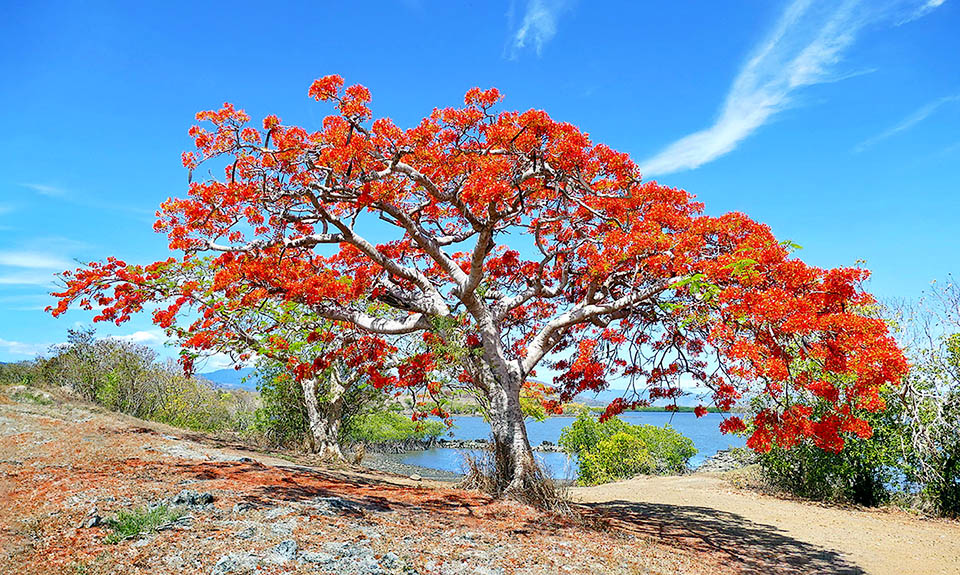
Delonix regia is a tree native to the Madagascar dry deciduous forest where it grows on karst soils, calcareous slopes and sandy grounds © Benoît Henry
Delonix regia (Bojer ex Hook.) Raf. is a species of the family Fabaceae, subfamily Caesalpinioideae, native to the dry deciduous forest of Madagascar where it is found on karst terrains and limestone slopes and also on sandy soils. Presently, due to the excessive exploitation done by the local populations, this species is in danger of extinction in its origin areas.
The genus Delonix is native to south-western Madagascar and can be traced back to approximately 24-18 million years ago. It is probable that the present African species have originated by dispersion outside Madagascar and that this has occurred during the Miocene thanks to the floating capacity of its long and flat pods.
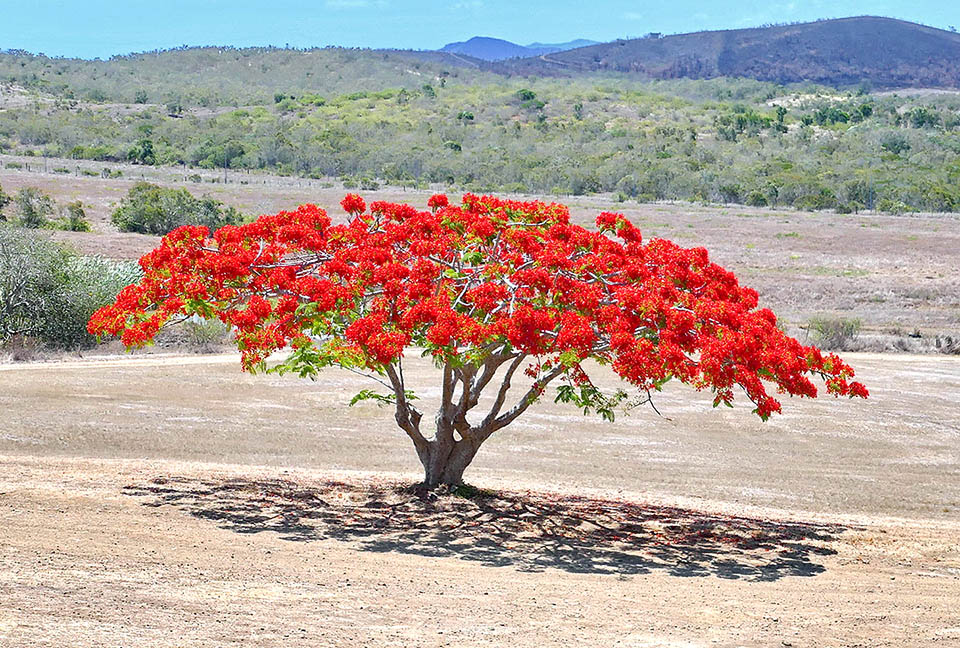
Introduced due to its beauty by man in many tropical and subtropical areas is now almost cosmopolitan as tolerates drought and saltiness © Benoît Henry
Delonix regia, due to the beauty of its flowerings, has been introduced by man in many tropical and subtropical areas of the world, where it has naturalized becoming cosmopolitan. Even in Australia, on Christmas Island and in some Pacific islands, it has become invasive, preventing the regeneration of the native species.
It may tolerate drought conditions and presence of saltiness. The average annual rainfall of the growing environments is 700-1800 mm. The highest temperature varies from 22 to 35 °C, the lowest from 6 to 18 °C. In some tropical sites it has been implanted up to an altitude of about 2000 m.
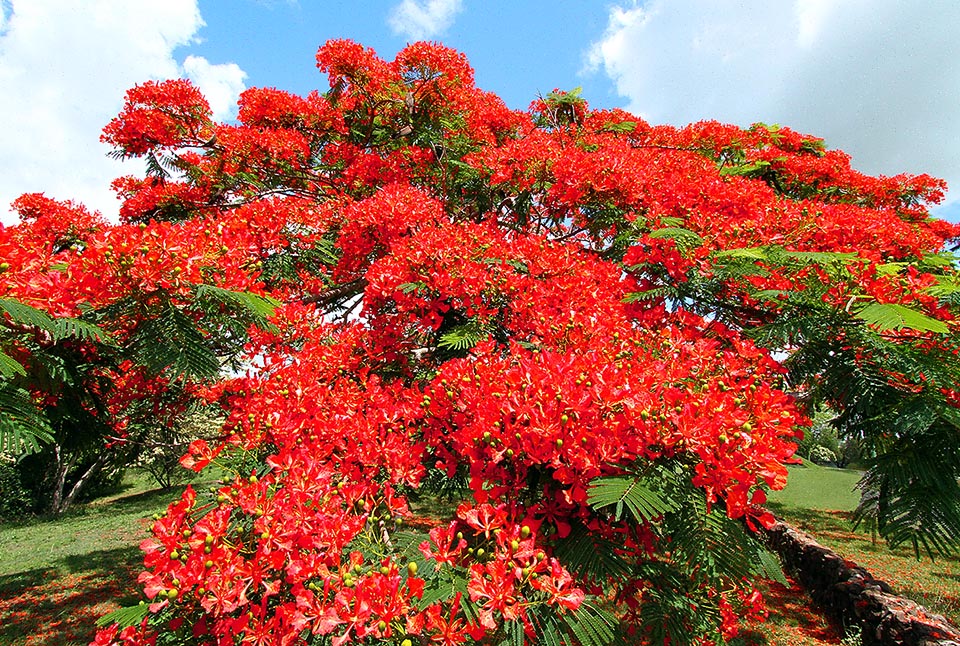
Accepting highest of 22-35 °C and lowest of 6-18 °C is often a guest of the gardens due to its dramatic blooming occurring all at once © John Forlonge
It is present in Florida, in the Rio Grande Valley (southern Texas), in southern Arizona and in southern California. It is found also in the Dominican Republic, Cuba, Haiti, Hawaii, Mexico (particularly in the Yucatan peninsula), Nicaragua, Puerto Rico, American Virgin Islands and in Israel. It grows also all over southern Brazil, in the Rio Grande do Sul (Canoas and Porto Alegre).
It is present in Paraguay, Peru, the Caribbean, in Africa, in northern Australia, Hong Kong,Canary Islands, Cyprus, Malta, Thailand, Vietnam, Philippines, Taiwan, southern China. In the Northern Marianas is the official tree of these islands. In Italy it grows only in the locations where the lowest temperature does not fall below its minimum limit, like, for instance, the areas of southern Sicily.
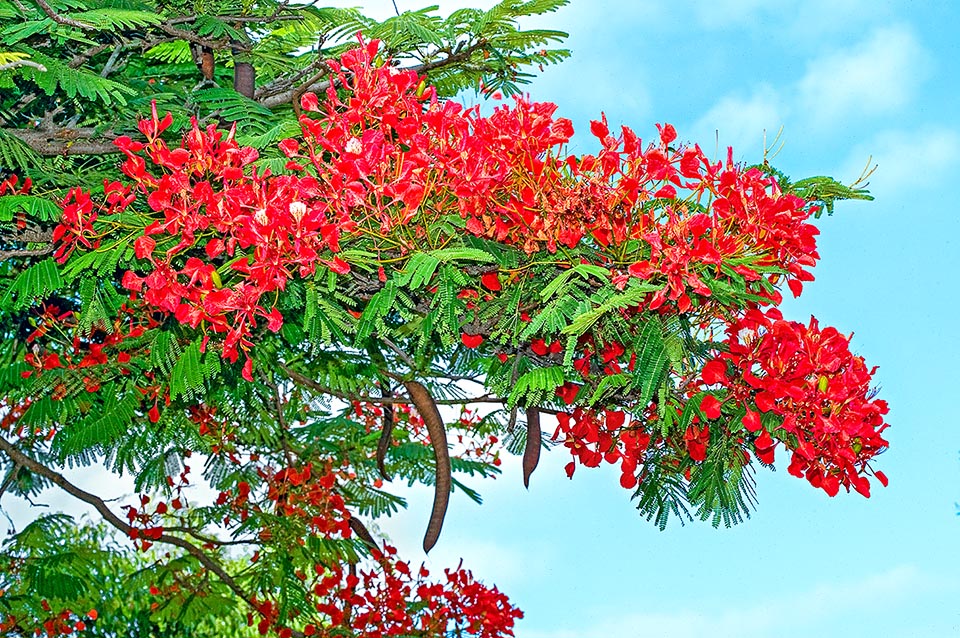
Delonix regia is a semi-evergreen plant with very elegant leaves falling only for a short time in the dry climates © Giuseppe Mazza
Flores Island, that belongs to the Lesser Sunda Islands, or Nusa Tenggara Islands, was so named by the Portuguese merchants, arrived on the island in the XVI century, because of the dramatic flowering of
Delonix regia they met in Cape Kopondai, in the eastern part of the island and that they called Cabo de Flores (“Cape of Flowers”).
The name of the species was published the first time by Constantine Samuel Rafinesque-Schmaltz (1783-1840) in Flora Telluriana (Fl. Tellur. 2: 92, 1837).
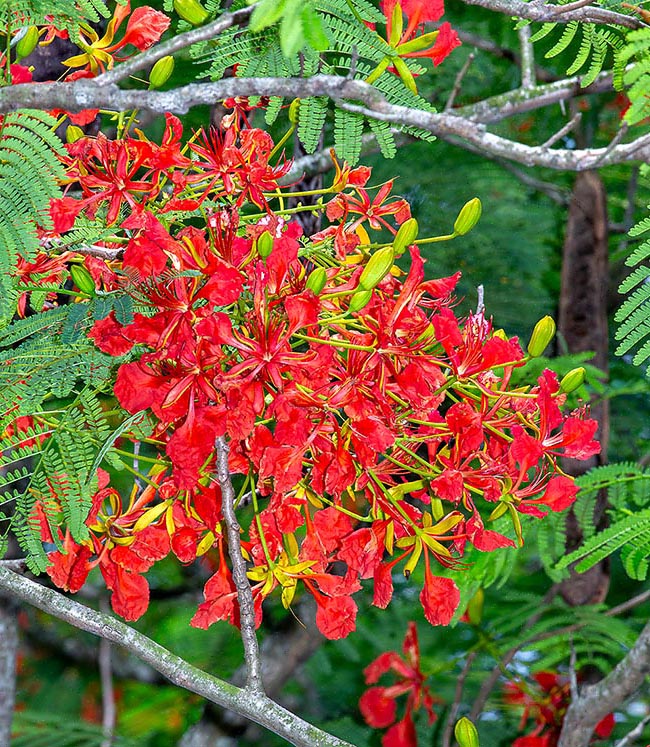
Blooming, though less abundant, accompanies them long time in the humid regions © Giuseppe Mazza
The generic name, Delonix, comes from the Greek “δηλος”(delos, evident) and ονυξ (onyx, claw), in allusion to the shape of the noticeably clawed petals. The specific name comes from the Latin “regis” (royal, regal, magnificent) due to the beauty of the flowers.
From 2011 this species is inserted in the category (LC, Least concern) of the Red List of the International Union for Conservation of Nature (IUCN).
In its places of origin it is protected from trade and as such inserted in the Appendix II of Washington Convention (CITES) that is intended to protect the animal and vegetable species preventing their export and detention.
Most of its common names come from its large bright red flowers. As a matter of fact, the most diffused common name is ‘Fire Tree’, in English ‘Gul Mohr’, ‘Peacock flower’, ‘Royal Poinciana’. In French, ‘Flamboyant’ with the meaning of “flaming” due to its explosive flowering happening all at once, with the entire crown covered by a multitude of flowers, even before the appearance of the leaves.
In Bengali (Bangladesh) this species is called ‘Rakta chura’ or ‘Radha chura’; in Tamil (Southern India) ‘Mayarum’ and in Malayalam (Southwestern India) ‘Alasippu’.
Delonix regia is a 3-15 (18) metres tall tree with shallow roots, cylindrical stem, strengthened towards the base, of about 50 cm of diameter, and with an umbrella-shaped crown widening due to its long horizontal branches. The appearance of the plant is therefore wider in diameter than in height.
The bark is smooth, at times slightly fissured, with lenticels.
The leaves are compound, paripinnate, by 10-24 (32) pairs of opposite leaflets, 7,5-10 mm long and 3,4-5 mm broad, finely pubescent. At the base of the leaf are present two stipules with long and comb-tight teeth.
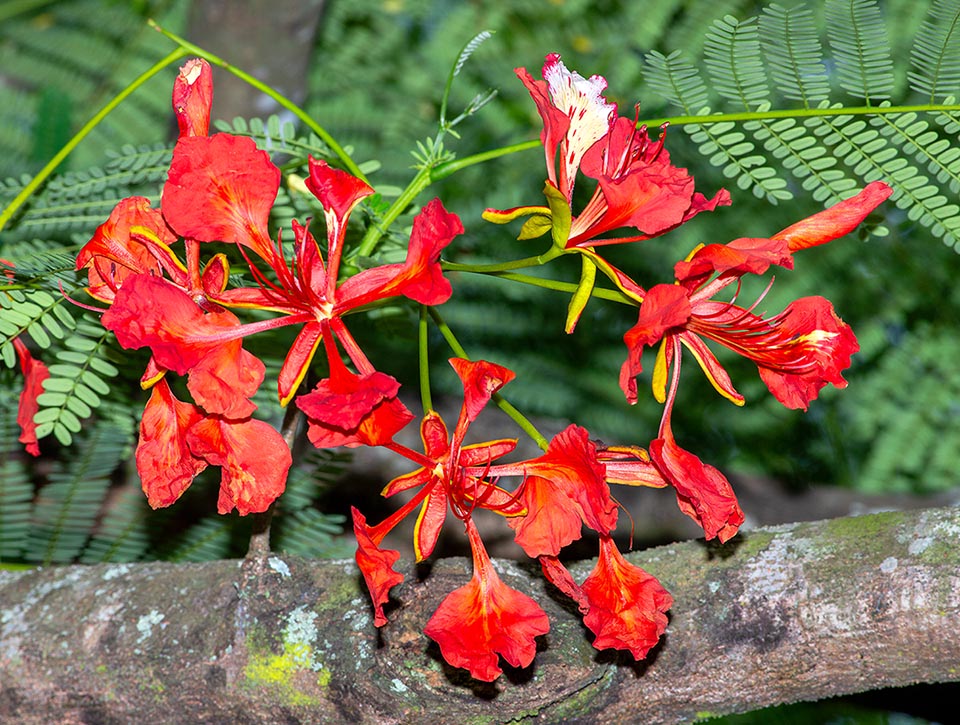
The slightly scented flowers and rich in nectar, are about 10 cm wide, arranged in racemose inflorescences corymb-like with 6-14 elements © Giuseppe Mazza
Delonix regia is a semi-evergreen plant because it loses the leaves for a short period of the year especially in the areas with a significantly dry season.
In India it has no leaves from March to May and the new leaves appear by the end of the warm season in May or June. Flowering takes place in April and May, when the tree is still leafless, and covers completely the crown.
In Vietnam the blooming occurs in May-July and coincides with the end of the school year and for this reason its flower is called “flower of the pupil”.
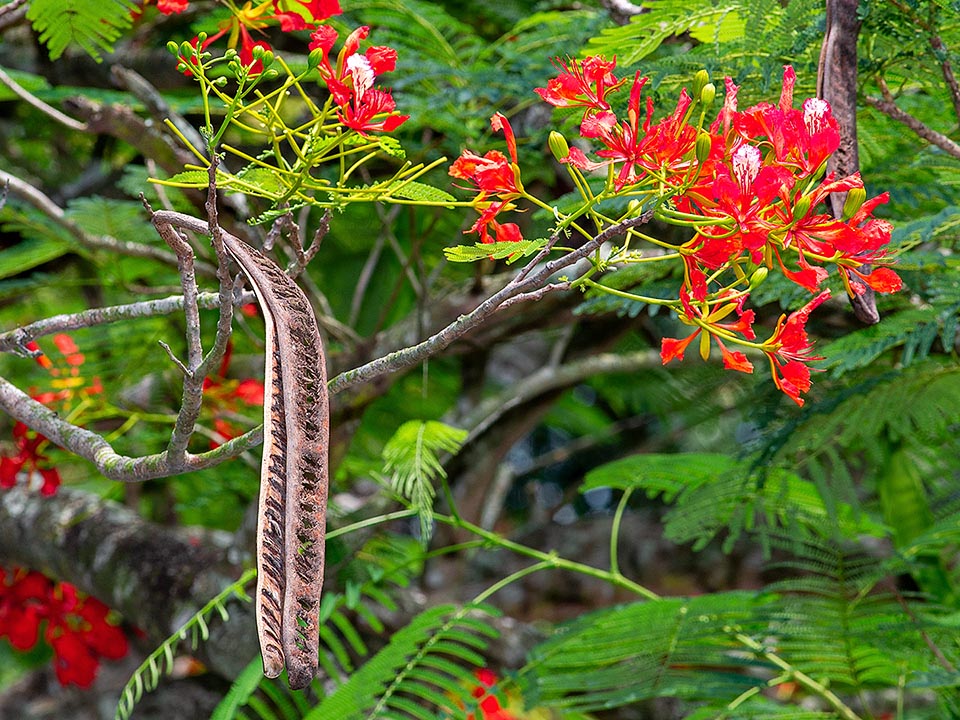
They are pollinated by bees and small birds. Here is visible also an open pod of the previous year that has released the seeds © Giuseppe Mazza
In Madagascar the blooming happens in the months of (September-) October – December (-January).
In the regions with heavy rainfalls the leaves form before the flowering that is reduced and less dramatic.
The flowers, about 10 cm broad, are arranged in racemose inflorescences, terminal or axillary, corymb like, with an up to 12 cm long axis, excluding the poorly pubescent peduncle. Each inflorescence is formed by (3) 6-14 slightly scented flowers and rich in nectar, source of food for the bees and pollinated also by small birds like the Souimanga sunbird [Cinnyris sovimanga (J.F.Gmelin, 1788), Nectariniidae].
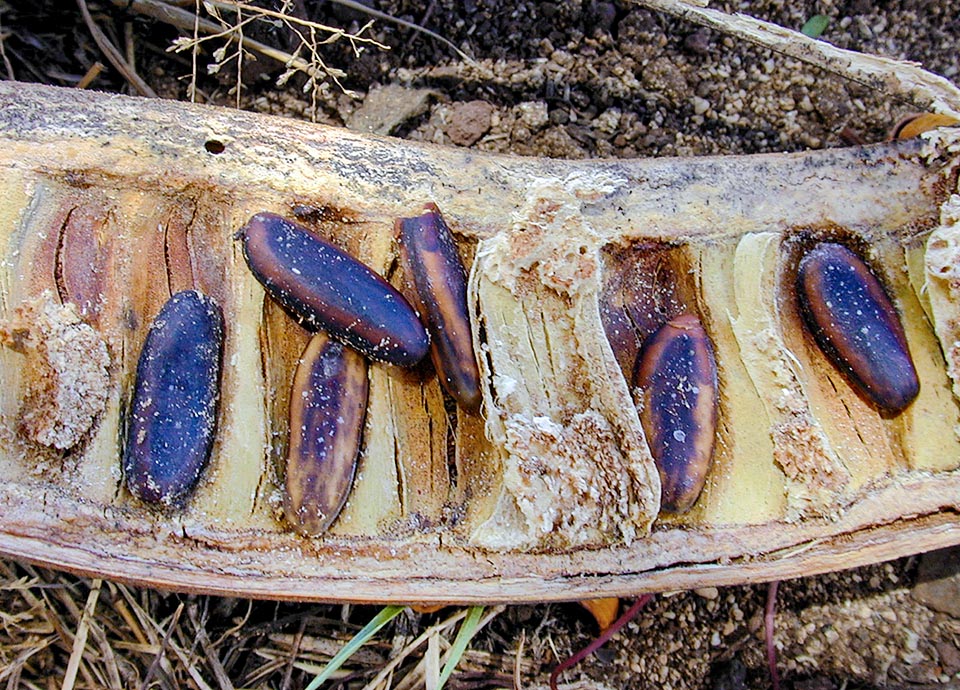
This, fallen on the soil, shows also the about 2 cm long seeds and immersed in transversal cavities of the woody endocarp that may contain even 50 of them © Forest and Kim Starr
The sepals, of green colour, are 1,8-3 cm long, lanceolate to oblong, glabrous or little pubescent.
The petals are clawed and are spoon-shaped with wavy distal margins. They are 4,2-6,5(7,4) cm long. The four lower ones are subequal whilst the upper one is slightly longer than the others with a broader nail. They are usually of scarlet red or sometimes orange or yellow colour, especially the upper petal that may appear speckled with red.
The petals are rich in ascorbic acid and have an appetizing sweet and sour flavour, and therefore are mainly eaten by the monkeys, at times by kids and used by the natives to produce sweets but also for colouring fabrics.
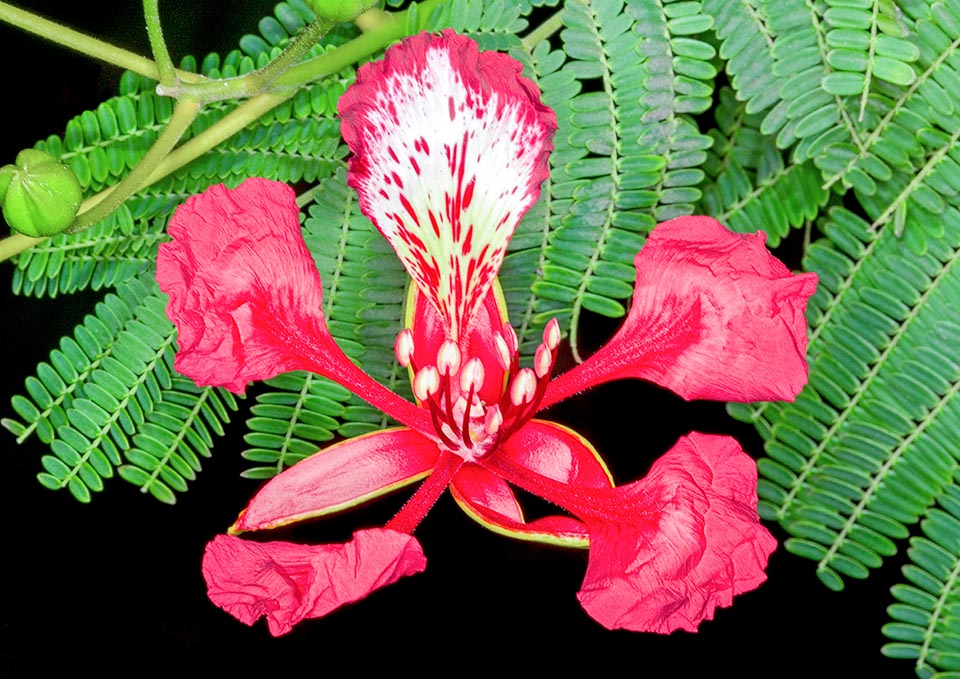
Close-up of a flower in the most frequent red colour with the characteristic petals shaped like a spoon. The upper one, slightly bigger is often mottled © Giuseppe Mazza
The ovary is more or less sessile, appressed-pubescent with long hairs but normally sparse.
The stamina are ten and have the 3,5-4,5(5) cm long filaments shorter than the petals.
The fruits are pods measuring (20)30-70 x 3,6-5,8 cm, woody when ripe, with the seeds dipped in transversal cavities of the woody endocarp. The pods rimen during the rain season and remain on the tree for a long time, often until the end of the following season. The seeds (2,0 x 0,6 x 0,4 cm) are numerous (40-50 or more) per pod, of linear-ellipsoidal shape, speckled, of dark brown colour that gets paler on the edges. Their collection is done during the months of December and January.
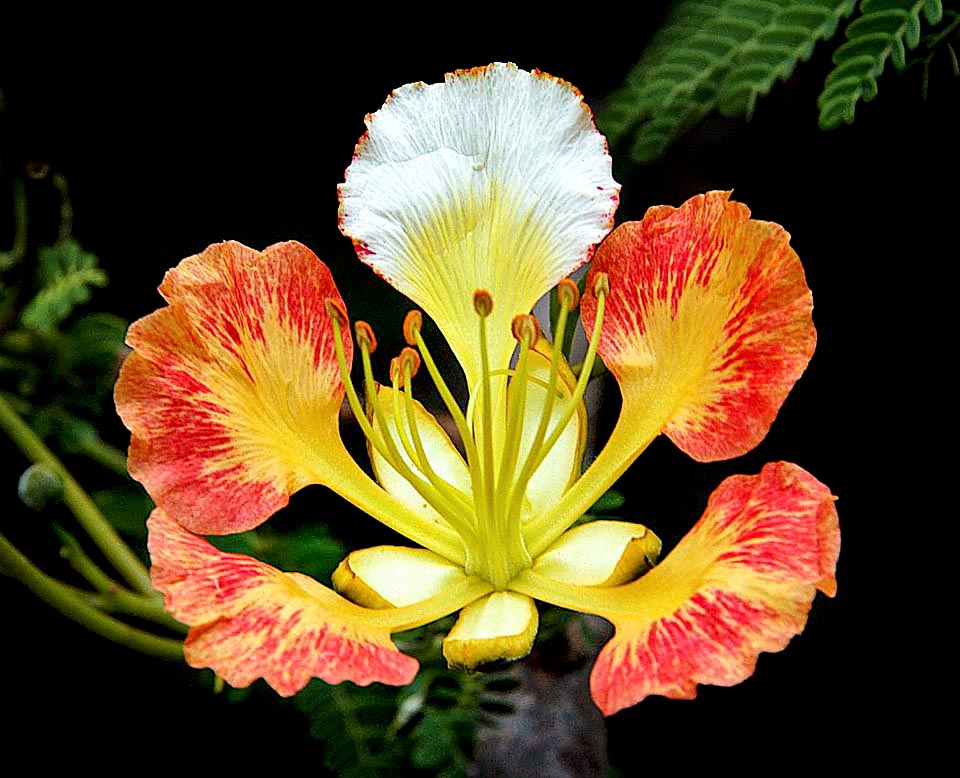
There are then showy colour variants like this, with yellow and orange petals and one nail partly white on the upper one © Mauricio Mercadante
The natives of the Caribbean use the pods and the ripe seeds as musical percussion instruments known as shak-shak.
Delonix regia is a very ornamental tree, widely utilized in the parks and in the gardens of the tropical zones or where the temperature never drops under 6 °C.
It loves the light, sandy, soils, even saline but does not tolerate water stagnation and frosts.
This plant, due to its shallow roots, is not suitable for road trees because it can collapse without any warning as has already happened in South Africa.
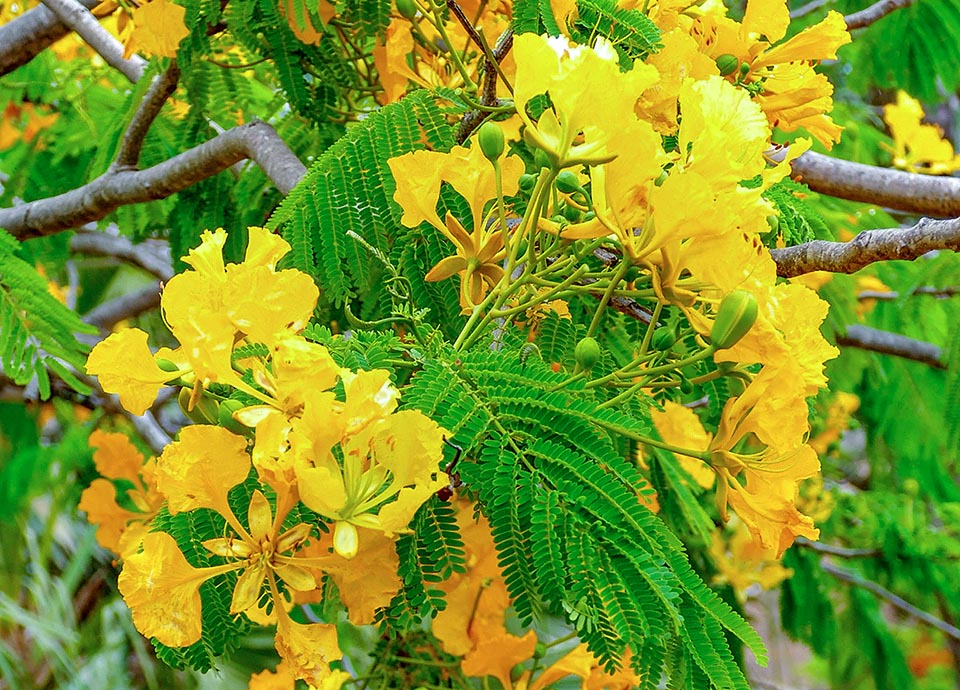
The tree may also present covered by bright yellow flowers, and whatever colour the petals are always sweet and edible © Benoît Henry
It easily propagates by seed that, due to the long dormancy, may require up to one year to germinate. The seeds are to be scarified before sowing and put in water for 24 hours so that they imbibe and are suitable for germination. When they are imbibed, they double their size and change their colour from dark brown to wine-red. From now on they can be buried. The most suitable period for sowing is during the spring or autumn season. It can propagate also by branch cutting. The seedlings planted may bloom after 4-5 years.
It is a shade tree useful for maintaining the humidity and for reducing the temperature of the ground. On eroded sites it is employed for controlling the erosion and for rehabilitating the soil thanks to its capacity of fixing the atmospheric nitrogen that enriches the same.
Delonix regia has antimicrobial, antifungal and antioxidant activities.
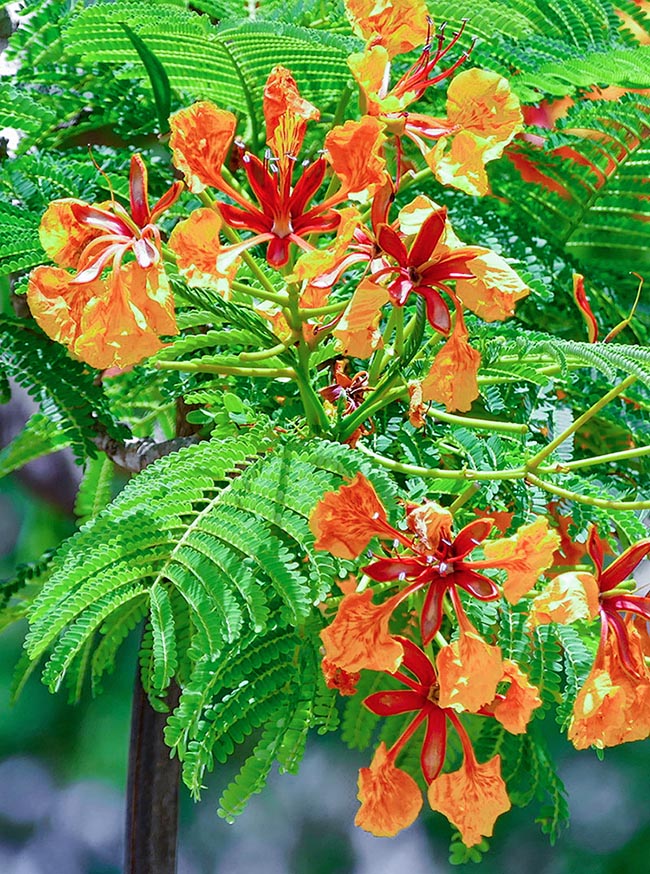
The orange shade is fairly rare. The sepals resume here darkening the mottlings of the petals © Benoît Henry
In the petals are present biologically active pigments: anthocyanins and carotenoids. In particular are reported seven carotenoids, five anthocyanins and several pigments having antioxidant power (astaxanthin, peonidin 3-O-beta-D-glucoside and petunidin-3-O-glucoside). The astaxanthin also has antibacterial and anti-obesity properties.
These substances occupy a special place in the pharmaceutical market due to their numerous health benefits.
In Mexico (Puebla and Veracruz) the bark is macerated and applied to the joints in order to soothe the pain caused by the rheumatisms. Always in Mexico, but in Michoacán, is administered, orally, the decoction of the flowers in case of respiratory problems like cough and bronchial asthma.
The seeds, rich in flavonoids, are utilized in tropical America as domestic wound agents. The leaves and flowers have herbicidal effects on Mikania micrantha Kunth, an invasive climbing plant.
Thanks to the mechanical shelling, the seeds may be utilized on a large scale as food (flour) for farm animals and for the production of biofuel.
The oil extracted from the seeds has the capacity of controlling the Maize weevil [Sitophilus zeamais (Motschulsky), 1855] that infests the caryopses of plants in the field. This weevil attacks also dried fruits, chestnuts, grain legumes, peanuts and sunflower seeds. The adult is capable of piercing the packaging of finished products (pasta, biscuits, bread, etc.). Therefore this oil, due to its insecticidal action, facilitates the stockage of these products.
Delonix regia is susceptible to the attacks of isoptera (termites) and drillers. In India, Bangladesh, Sri Lanka and Indonesia the moth Pteroma plagiophleps Hampson, 1892 (family Psychidae) attacks the plants growing in the avenues.
In Israel they encountered a serious epidemic caused by the Bostrichid Sinoxylon anale Lesne, 1897. Similarly, in Nagaland (India) larvae of the noctuid Pericyma cruegeri (Butler, 1886) have created severe tree defoliations. Analogous defoliation has been observed in Kenya by larvae of Bourgognea reimeri Gaede, 1929, small lepidopterans diffused in eastern Africa.
In northern Guinea they have observed cases of root rot caused by the fungus Fusarium oxysporum von Schlechtendal.
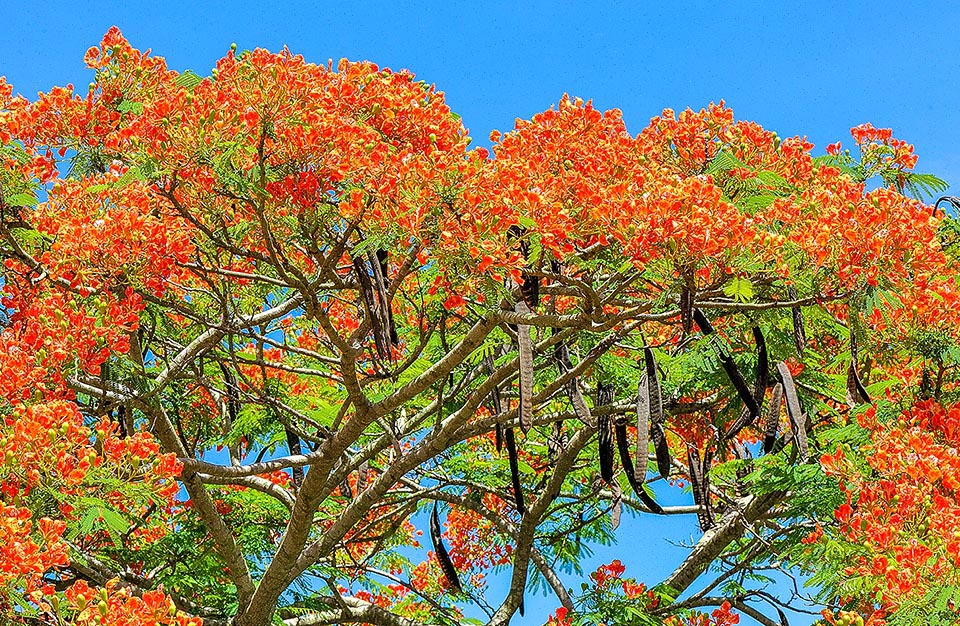
Dramatic triumph of orange with numerous hanging fruits. Almost all parts of the plant, seeds included, have medicinal virtues © Ming-I Weng
In India the ascomycete Pleiochaeta setosa (Kirchn.) S. Hughes, has been noted on the germinating cotyledons and on the leaves of the young seedlings, causing their wilting and falling. Also Corallomycetella elegans Herrera & P. Chaverri (2013), parasite of cocoa and of the tea trees, can attack Delonix regia causing the sickness called the “stinking roots”. The infection occurs by means of spores carried by the water in contact with the roots.
Delonix regia is the main guest of the plant pathogenic nematode Helicotylenchus dihystera Sher, 1961.
Synonyms: Caesalpinia regia (Bojer ex Hook.) D.Dietr. ; Delonix regia var. genuina Stehlé; Poinciana regia Bojer ex Hook.; Delonix regia var. flavida Stehlé.
→ To appreciate the biodiversity within the family of FABACEAE please click here.
